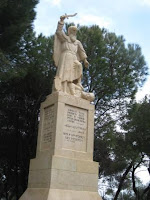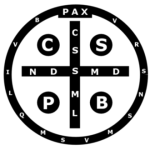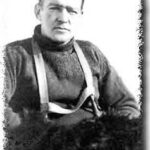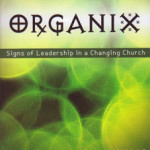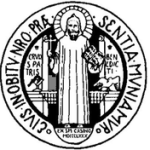Today we visited some of the most consistently interesting places, all interesting for different reasons.
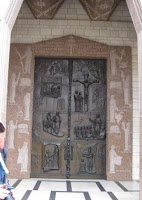 |
| Entrance to the Church of the Annunciation |
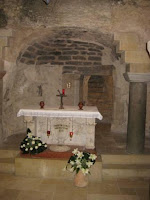 |
| Cave of the annunciation |
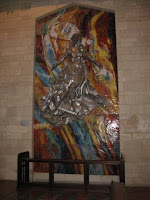 |
| The Madonna of the U.S.A. |
 |
| Madonna of Japan |
We first had two stops in Nazareth, Jesus’ home town. The Church of the Annunciation contains a cave where supposedly Mary was visited by the angel. While I do not know if that cave is the place, or why Mary anyone would assume Mary was not at home when the angel visited, the church is still interesting because of the art. Countries from around the world contributed money to the building of the church and by their donation were allowed space for an annunciation art piece. It was easy to guess that the U.S.A.’s contribution was the metallic wonder woman on fire version of Mary. Other countries, such as Japan and, I believe Cameroon (the plaque was beyond my visual range), depicted the Madonna in their own ethnic way, others, like the French, in a more traditional way.
 |
| Madonna of France |
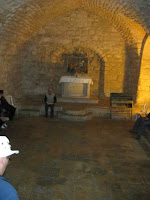 |
| Nazareth Synagogue |
Our second stop was to the synagogue in Nazareth. Although it has not been excavated, it is sure that the synagogue that Jesus announced his fulfillment of Isaiah 61, and was then rejected by his home town is beneath the ground because synagogues have always been built upon each other. We read the story from Luke 4, sang hymns, and gave thanks that Jesus came to preach good news to the poor, proclaim freedom for the prisoners, recovery of sight for the blind, to release the oppressed, and to proclaim the year of the Lord’s favor. However, Jesus’ words at the time caused his hearers to want to throw him off a cliff, and they would not have to have gone far. Nazareth is up in the hill country, and there are plenty of good cliffs to toss someone off, and an especially good one by the rock quarry.
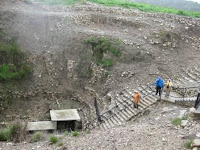 |
| Megiddo water access |
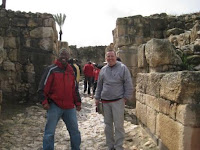 |
| Paul and Shawn at the Megiddo Gate |
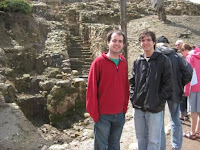 |
| Jeremy and Ryan at Megiddo |
The city Megiddo has been excavated at the levels of Joshua, Solomon, Jeroboam, and Ahab, and we could both see and walk through different eras revealed. Two interesting aspects here were an animal trough and the water spring. Dr. Williams pointed out that in all their excavations, they ever have found a cup, so when David writes “my cup overflows” (Psalm 23:5) that he may be referring to an animal trough. That is one big “cup,” and makes sense with the shepherding imagery. However, the immediate context has the writer at a table, so it may just be a regular cup. Regarding the spring, King Ahab wanted to be able to access it from inside the city, so he ordered the big dig. The resulting hole and tunnel goes deep and runs long, and we got to walk it.
 |
| My animal trough overflows? |
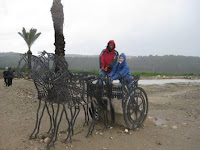 |
| Paul and Kathryn ride a chariot |
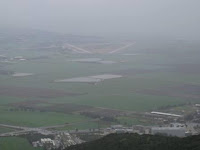 |
| Kishon Valley |
Elijah is honored on Mount Carmel because it is here that he challenged and the Lord defeated the prophets of Baal. It was easy to picture Elijah building an altar there, as it was full of all sizes of field stones. Down below, in the Kishon Valley, all the prophets of Baal were killed for being false prophets since Baal did not produce rain.
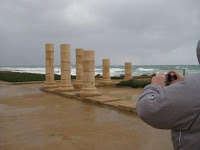 |
| Herod’s Palace |
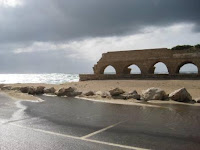 |
| Caesarean Aqueduct |
Our first chance to take a dip in Mediterranean Sea was at Caesarea. Unfortunately it was about 45 degrees, raining, with a driving wind. We still chose to brave the wind and rain to spend some time at the aqueduct. From there we went to Caesarea proper, where we saw the remnant of Herod’s palace (where Paul had a trial before Felix), The Hippodrome, and an inscription that has Pontius Pilate’s name on it.
©2011 Paul Tillman















